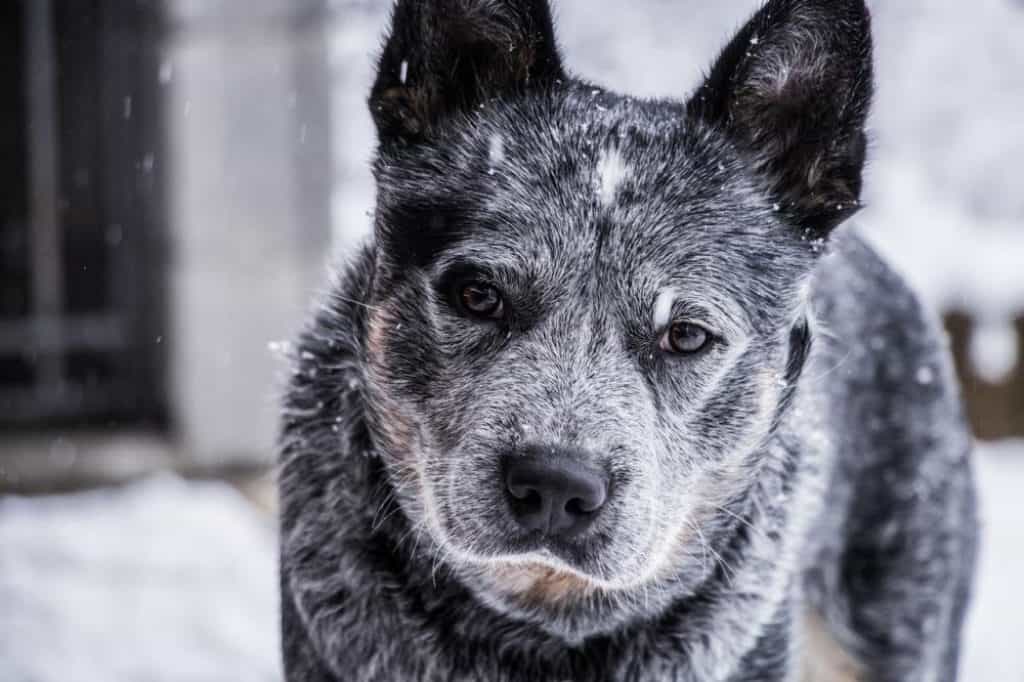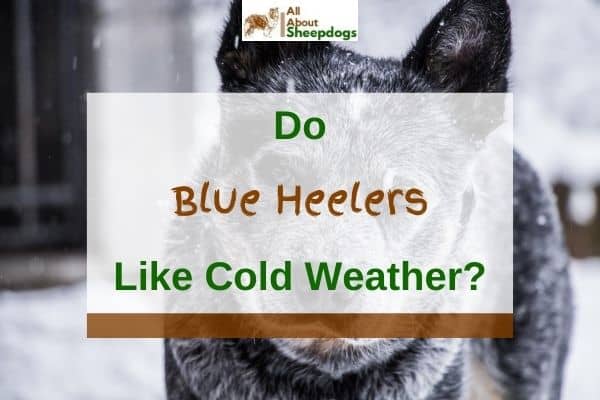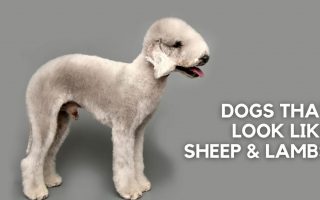Spending your day outside walking, running, or playing with your dog is a great way to strengthen the bond with your four-legged friend.
It also allows them to let all the extra energy loose.
But, once the winter comes, many owners wonder if it’s too cold to take their dogs outside. Running around in the snow with kids and pets is always loads of fun.
However, for some breeds, it may be harmful and affect their health.
For those owning a Blue Heeler, aka Australian Cattle Dog, it’s a crucial dilemma as this breed usually spends most of its time outdoors.
Knowing that they originate from the Southern Hemisphere, it’s natural to ask do Blue Heelers like cold weather, and how they fare in the snow.
[wpsm_toplist]
Do Blue Heelers Like Cold Weather?

Blue Heelers were developed to perform tough herding assignments in the Australian Outback.
This often implied following the livestock across the rough terrain and in harsh weather.
Although we often think of Australia as scorching hot, winters can be very cold, especially in the continental parts.
So, Blue Heelers are genetically ready for dealing with freezing weather.
While they don’t enjoy being in the cold as much as some of the northern breeds, such as Akita, Alaskan Malamut, or Samoyed, Australian Cattle Dogs are more than prepared for winter.
Blue Heelers have their double coat as protection from cold, wind, rain, or snow.
The undercoat is thick and dense and provides natural insulation when it’s freezing outside.
The outercoat’s role is to protect against the wind and shed water and snow, keeping the skin mostly dry at all times.
In addition, Blue Heelers mostly love being outside in the winter. They’re always excited to join you for a run or hike, even in knee-deep snow.
As long as you stay outside, they will keep you company, even if they start feeling cold themselves.
Health And Safety Issues When It Gets Too Cold
As a breed, they’re so loyal and attached to humans that they won’t even think about going inside to get warm until you decide so.
This can lead to certain health and safety issues.
To make sure that this doesn’t happen, you should always keep a close eye on your dog’s behavior while out in the cold.
Here are some signs that can tell you that it’s time to go back inside and get warm.
Pay attention if your dog:
- starts to shake and shiver
- excessively barks and whines
- uncomfortably tucks the tail between its legs and holds the ears close to the head
- tries to lift its paws off the cold ground
- seems reluctant to go on and loses the will to play
What Temperature Is Too Cold For Blue Heelers?

As we said, Blue heelers are more than happy to stay by your side no matter how cold it is.
That’s why it’s up to you to decide if the temperature is too cold for your dog. The list below should help you decide when it’s safe to take your dog outside.
Of course, you should also pay attention to other weather elements.
For example, the same temperature won’t have the same effect if there’s a chilling wind blowing outside.
| Temperature | Blue Heeler |
| 50 – 70°F (10 – 20°C) | An ideal outside temperature for Blue Heelers |
| 40 – 50°F (5 – 10°C) | The dog still can go outside, but try to keep it dry |
| 30 – 40°F (0 – 5°C) | Can spend some time outside, but take extra precautions |
| 15 – 30°F (-10 – 0°C) | Possibly dangerous for dog’s health |
| below 15°F (below -10°C) | Allow short and necessary exposure only |
Do Australian Cattle Dogs Need Winter Coats?
[amazon box=”B01IYGE84A”]
Australian Cattle Dogs are extremely active and energetic and need constant exercise.
This means that they have to be engaged in physical activity all year, including winter.
Many owners don’t think too much about the question do Blue Heelers like cold weather but put a winter coat on their pooches just to be on the safe side.
The truth is, in most cases, ACD’s don’t really need the winter coat. The combination of their double coat and intense activity is usually enough to keep them warm enough.
However, when it’s particularly cold, icy, or raining outside, some extra protection is a good idea. Especially if you plan to spend a long time outside.
When choosing a coat, make sure you put functionality over aesthetics. Your dog looking cool won’t matter much if he’s still cold and wet.
The [amazon link=”B01IYGE84A” title=”winter coat” link_icon=”amazon” /] needs to be padded, warm, and waterproof. Additionally, look for coats that are practical and can easily be put on and off.
And finally, your dog should feel comfortable wearing it, so it should fit its size and build.
Do Blue Heelers Need Snow Boots?
[amazon box=”B089RJBPHR”]
A lot of owners reject even the very notion of their dog wearing snow boots.
And, to some point, they’re right. Putting snow boots on your Blue Heeler might make it feel awkward and take away his comfort while running or playing.
Still, in some cases, [amazon link=”B089RJBPHR” title=”Snow Boots” link_icon=”amazon” /] can be very practical. Salt and de-icers used for melting snow and ice can often leave toxic residue.
If your walking route takes you through the area where these are used, it might be a good idea to protect your dog’s paws.
Also, if your dog has a cut or a scratch on his paw, then it needs to be protected so walking on the snow or ice won’t further aggravate the injury.
Winter Dangers To Dogs
Just like with humans, staying in the cold too long can be harmful to dogs, even the resilient ones like Blue Heelers.
Overexposure to freezing temperatures can cause frostbites or hypothermia.
If your dog’s spend too much time in freezing conditions, their extremities tissue can freeze and die.
The pads on the paws, ears and tip of the tail are the most susceptible to frostbites. If this happens, the affected tissue can even fall off.
Besides, if you’re not careful while it’s freezing cold outside, the dog’s body temperature will fall way below the normal level, leading to hypothermia.
The hypothermia starts with shivering and makes the dog weak and inactive.
As the conditions worsen, their breathing and heart rate slow down and they become unresponsive.
If you notice any of these symptoms, make sure to warm up your dog immediately and take him to the vet as soon as possible.
Conclusion
Most of the Blue Heelers tolerate the cold weather well. They’re more than happy to keep you company while running or goofing around in the snow.
A Blue Heeler won’t leave your side no matter how much time you spend out in the cold. Thanks to their thick double coat, they’ll handle all but freezing temperatures.
However, you must be aware that prolonged stay in cold weather takes a toll on their bodies.
Make sure to always be on the lookout for any warning signs that your dog might be getting too cold.
Otherwise, with some necessary precaution, there’s nothing to stop you from fully enjoying the winter side-by-side with your Blue Heeler.







